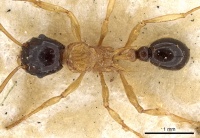Tetramorium diligens
| Tetramorium diligens | |
|---|---|

| |
| Scientific classification | |
| Kingdom: | Animalia |
| Phylum: | Arthropoda |
| Class: | Insecta |
| Order: | Hymenoptera |
| Family: | Formicidae |
| Subfamily: | Myrmicinae |
| Tribe: | Crematogastrini |
| Genus: | Tetramorium |
| Species: | T. diligens |
| Binomial name | |
| Tetramorium diligens (Smith, F., 1865) | |
| Synonyms | |
| |
Nothing is known about the biology of Tetramorium diligens.
Identification
Bolton (1977) - This distinctive species appears closest related to Tetramorium carinatum but in that species the head is broader, the scapes shorter, the integument more densely sculptured and the meta pleural lobes are dentiform.
Two other New Guinea species, Tetramorium bicolor and Tetramorium tricarinatum, have the same distinctive coloration as diligens, but both of these species belong to the bicarinatum-group and hence have 12-segmented antennae and a dentiform sting-appendage.
Distribution
Distribution based on Regional Taxon Lists
Indo-Australian Region: New Guinea (type locality).
Distribution based on AntMaps
Distribution based on AntWeb specimens
Check data from AntWeb
Countries Occupied
| Number of countries occupied by this species based on AntWiki Regional Taxon Lists. In general, fewer countries occupied indicates a narrower range, while more countries indicates a more widespread species. |

|
Estimated Abundance
| Relative abundance based on number of AntMaps records per species (this species within the purple bar). Fewer records (to the left) indicates a less abundant/encountered species while more records (to the right) indicates more abundant/encountered species. |

|
Biology
Castes
Images from AntWeb

| |
| Syntype of Tetramorium diligens. Worker. Specimen code casent0901111. Photographer Ryan Perry, uploaded by California Academy of Sciences. | Owned by NHMUK, London, UK. |
Nomenclature
The following information is derived from Barry Bolton's Online Catalogue of the Ants of the World.
- diligens. Myrmica diligens Smith, F. 1865: 73 (w.) NEW GUINEA. Combination in Xiphomyrmex: Donisthorpe, 1932c: 473; in Tetramorium: Bolton, 1977: 87. Senior synonym of diligentissima: Bolton, 1995b: 407.
- diligentissima. Pheidole diligentissima Dalla Torre, 1892: 90. [Unnecessary replacement name for diligens Smith, above.] Junior synonym of diligens: Bolton, 1995b: 407.
Unless otherwise noted the text for the remainder of this section is reported from the publication that includes the original description.
Description
Worker
Bolton (1977) - TL 3.8-3.9, HL 0.92-0.94, HW 0.74-0.78, CI 80-83, SL 0.96-1.00, SI 128-129, PW 0.62-0.66, AL 1.12 (2 measured).
Mandibles very feebly striate; antennal scapes long, SI> 120. Frontal carinae extended back only tothe level of the posterior margin of the eye and terminating in this vicinity. Scrobes virtually non-existent, merely a very shallow impression below the frontal carinae. Propodeal spines stout and very long, the metapleural lobes very reduced, low and broadly rounded, not dentiform, scarcely or not visible when the alitrunk is viewed in profile. Peduncle of petiole long, the node high and narrow in profile with a concave anterior face (Fig. 4). Dorsum of head mostly unsculptured, with one or two short rugulae between the frontal carinae, the median cephalic carina fading out posteriorly. Vertex unsculptured, smooth and shining. Dorsal alitrunk with a few coarse and widely spaced rugae, pedicel and gaster unsculptured. Bicoloured, the head and gaster blackish brown, the alitrunk, legs and antennae yellow. In the Syntypes the petiole is yellow-brown, the postpetiole darker, almost as dark as the gaster.
Type Material
Bolton (1977) - Syntype workers, New Guinea (A. R. Wallace) (Oxford University Museum of Natural History; The Natural History Museum) [examined].
The following notes on F. Smith type specimens have been provided by Barry Bolton (details):
Myrmica diligens
One worker syntype in Oxford University Museum of Natural History, one worker syntype in The Natural History Museum. Both labelled “N” (= New Guinea).
References
- Bolton, B. 1977. The ant tribe Tetramoriini (Hymenoptera: Formicidae). The genus Tetramorium Mayr in the Oriental and Indo-Australian regions, and in Australia. Bulletin of the British Museum (Natural History). Entomology. 36:67-151. (page 87, Combination in Tetramorium)
- Bolton, B. 1995b. A new general catalogue of the ants of the world. Cambridge, Mass.: Harvard University Press, 504 pp. (page 407, Senior synonym of diligentissima)
- Donisthorpe, H. 1932c. On the identity of Smith's types of Formicidae (Hymenoptera) collected by Alfred Russell Wallace in the Malay Archipelago, with descriptions of two new species. Ann. Mag. Nat. Hist. 10(10): 441-476 (page 473, Combination in Xiphomyrmex)
- Smith, F. 1865a. Descriptions of new species of hymenopterous insects from the islands of Sumatra, Sula, Gilolo, Salwatty, and New Guinea, collected by Mr. A. R. Wallace. J. Proc. Linn. Soc. Lond. Zool. 8: 61-94 (page 73, worker described)
References based on Global Ant Biodiversity Informatics
- Bolton B. 1977. The ant tribe Tetramoriini (Hymenoptera: Formicidae). The genus Tetramorium Mayr in the Oriental and Indo-Australian regions, and in Australia. Bulletin of the British Museum (Natural History). Entomology 36:67-151.
- Chapman, J. W., and Capco, S. R. 1951. Check list of the ants (Hymenoptera: Formicidae) of Asia. Monogr. Inst. Sci. Technol. Manila 1: 1-327
- Janda M., G. D. Alpert, M. L. Borowiec, E. P. Economo, P. Klimes, E. Sarnat, and S. O. Shattuck. 2011. Cheklist of ants described and recorded from New Guinea and associated islands. Available on http://www.newguineants.org/. Accessed on 24th Feb. 2011.
- Smith F. 1865. Descriptions of new species of hymenopterous insects from the islands of Sumatra, Sula, Gilolo, Salwatty, and New Guinea, collected by Mr. A. R. Wallace. Journal and Proceedings of the Linnean Society of London. Zoology 8: 61-94.

